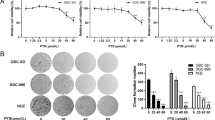Abstract
Gallbladder cancer is the most common and aggressive type of biliary tract cancer with poor prognosis due to both its inability to be detected at an early stage and its poor sensitivity to conventional therapies. Gemcitabine has been more and more widely used for the treatment of gallbladder cancer; however, the response rate is not satisfactory. Phenoxodiol is an isoflavone analog with antitumor activity against a variety of cancers. In our current work, we examined the effect of phenoxodiol on gallbladder cancer cells and to determine whether phenoxodiol can enhance the antitumor activity of gemcitabine in gallbladder cancer. The combined treatment of phenoxodiol and gemcitabine was more effective at inhibiting cell proliferation than either chemotherapeutic agent treatment alone. Meanwhile, phenoxodiol arrests cell cycle progression in the G0–G1 phase. In addition, phenoxodiol and gemcitabine inhibit the phosphorylation of PI3K/Akt-signaling pathway as well as modulate the expression of apoptosis-relevant molecules. Furthermore, the antitumor effect of combination treatment with phenoxodiol and gemcitabine on gallbladder cancer was evaluated using a murine gallbladder cancer xenograft model and the results suggested that phenoxodiol enhanced the in vivo antitumor activity of gemcitabine. Taken together, our study suggested that the combination treatment with phenoxodiol and gemcitabine might offer optimal therapeutic benefits for patients with gallbladder cancer.





Similar content being viewed by others
References
Reid, K. M., Ramos-De la Medina, A., & Donohue, J. H. (2007). Diagnosis and surgical management of gallbladder cancer: A review. The Journal of Gastrointestinal Surgery, 11, 671–681.
Kaneoka, Y., Yamaguchi, A., Isogai, M., Harada, T., & Suzuki, M. (2003). Hepatoduodenal ligament invasion by gallbladder carcinoma: Histologic patterns and surgical recommendation. World Journal of Surgery, 27, 260–265.
Wang, J. W., Peng, S. Y., Li, J. T., Wang, Y., Zhang, Z. P., Cheng, Y., et al. (2009). Identification of metastasis-associated proteins involved in gallbladder carcinoma metastasis by proteomic analysis and functional exploration of chloride intracellular channel 1. Cancer Letters, 281, 71–81.
Zhu, A. X., Hong, T. S., Hezel, A. F., & Kooby, D. A. (2010). Current management of gallbladder carcinoma. Oncologist, 15, 168–181.
Alvero, A. B., O’Malley, D., Brown, D., et al. (2006). Molecular mechanism of phenoxodiol-induced apoptosis in ovarian carcinoma cells. Cancer, 106, 599–608.
Mita, Y., Ajiki, T., Kamigaki, T., Okazaki, T., Hori, H., Horiuchi, H., et al. (2007). Antitumor effect of gemcitabine on orthotopically inoculated human gallbladder cancer cells in nude mice. Annals of Surgical Oncology, 14, 1374–1380.
Chou, T. C., & Talalay, P. (1984). Quantitative analysis of dose-effect relationships: The combined effects of multiple drugs or enzyme inhibitors. Advances in Enzyme Regulation, 22, 27–55.
Wang, W., Sun, Y. P., Huang, X. Z., He, M., Chen, Y. Y., Shi, G. Y., et al. (2010). Emodin enhances sensitivity of gallbladder cancer cells to platinum drugs via glutathion depletion and MRP1 downregulation. Biochemical Pharmacology, 79, 1134–1140.
Zhang, D. C., Liu, J. L., Ding, Y. B., Xia, J. G., & Chen, G. Y. (2013). Icariin potentiates the antitumor activity of gemcitabine in gallbladder cancer by suppressing NF-κB. Acta Pharmacologica Sinica, 34(2), 301–308.
Kamsteeg, M., Rutherford, T., Sapi, E., Hanczaruk, B., Shahabi, S., Flick, M., et al. (2003). Phenoxodiol—an isoflavone analog—induces apoptosis in chemoresistant ovarian cancer cells. Oncogene, 22(17), 2611–2620.
Yao, C., Wu, S., Li, D., Ding, H., Wang, Z., Yang, Y., et al. (2012). Co-administration phenoxodiol with doxorubicin synergistically inhibit the activity of sphingosine kinase-1 (SphK1), a potential oncogene of osteosarcoma, to suppress osteosarcoma cell growth both in vivo and in vitro. Molecular Oncology, 6(4), 392–404.
Yang, C., Xu, M., Shen, H. J., Zhu, H. Y., Li, F., He, M., et al. (2014). Potential biomarkers for sensitivity of gallbladder cancer cells to gemcitabine. International journal of clinical and experimental pathology, 7(2), 521–528.
Ono, M., Higuchi, T., Takeshima, M., Chen, C., & Nakano, S. (2013). Antiproliferative and apoptosis-inducing activity of curcumin against human gallbladder adenocarcinoma cells. Anticancer Research, 33(5), 1861–1866.
Byun, H. J., Kim, B. R., Yoo, R., Park, S. Y., & Rho, S. B. (2012). sMEK1 enhances gemcitabine anti-cancer activity through inhibition of phosphorylation of Akt/mTOR. Apoptosis, 17(10), 1095–1103.
Ke, X. Y., Wang, Y., Xie, Z. Q., Liu, Z. Q., Zhang, C. F., Zhao, Q., et al. (2013). LY294002 enhances inhibitory effect of gemcitabine on proliferation of human pancreatic carcinoma PANC-1 cells. Journal of Huazhong University of Science and Technology. Medical Sciences, 33(1), 57–62.
Li, Q., & Yang, Z. (2009). Expression of phospho-ERK1/2 and PI3-K in benign and malignant gallbladder lesions and its clinical and pathological correlations. Journal of Experimental and Clinical Cancer Research, 18(28), 65.
Author information
Authors and Affiliations
Corresponding author
Rights and permissions
About this article
Cite this article
Li, Y., Huang, X., Huang, Z. et al. Phenoxodiol Enhances the Antitumor Activity of Gemcitabine in Gallbladder Cancer Through Suppressing Akt/mTOR Pathway. Cell Biochem Biophys 70, 1337–1342 (2014). https://doi.org/10.1007/s12013-014-0061-y
Published:
Issue Date:
DOI: https://doi.org/10.1007/s12013-014-0061-y




